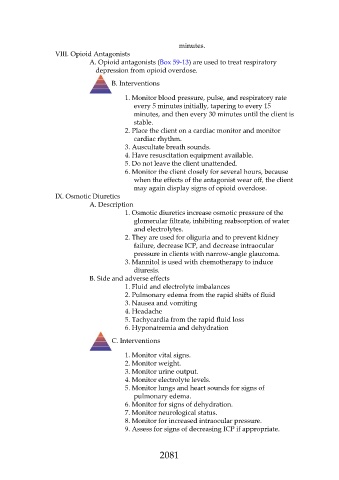Page 2081 - Saunders Comprehensive Review For NCLEX-RN
P. 2081
minutes.
VIII. Opioid Antagonists
A. Opioid antagonists (Box 59-13) are used to treat respiratory
depression from opioid overdose.
B. Interventions
1. Monitor blood pressure, pulse, and respiratory rate
every 5 minutes initially, tapering to every 15
minutes, and then every 30 minutes until the client is
stable.
2. Place the client on a cardiac monitor and monitor
cardiac rhythm.
3. Auscultate breath sounds.
4. Have resuscitation equipment available.
5. Do not leave the client unattended.
6. Monitor the client closely for several hours, because
when the effects of the antagonist wear off, the client
may again display signs of opioid overdose.
IX. Osmotic Diuretics
A. Description
1. Osmotic diuretics increase osmotic pressure of the
glomerular filtrate, inhibiting reabsorption of water
and electrolytes.
2. They are used for oliguria and to prevent kidney
failure, decrease ICP, and decrease intraocular
pressure in clients with narrow-angle glaucoma.
3. Mannitol is used with chemotherapy to induce
diuresis.
B. Side and adverse effects
1. Fluid and electrolyte imbalances
2. Pulmonary edema from the rapid shifts of fluid
3. Nausea and vomiting
4. Headache
5. Tachycardia from the rapid fluid loss
6. Hyponatremia and dehydration
C. Interventions
1. Monitor vital signs.
2. Monitor weight.
3. Monitor urine output.
4. Monitor electrolyte levels.
5. Monitor lungs and heart sounds for signs of
pulmonary edema.
6. Monitor for signs of dehydration.
7. Monitor neurological status.
8. Monitor for increased intraocular pressure.
9. Assess for signs of decreasing ICP if appropriate.
2081

